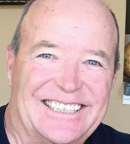
Chip Baldwin
In the fall of 2015, I was looking forward to a trip to Florida for a visit with my daughter and her family, along with a little relaxation. The evening before the trip, I experienced some abdominal pain that my wife, Angela, and I thought might be appendicitis. Concerned the problem could jeopardize our trip, I went to our local urgent care clinic for a checkup and blood tests; they showed that my white blood cell count was high enough for the physician-in-charge to immediately send me to an imaging center for a computed tomography (CT) scan.
I’ll never forget the look on the doctor’s face when she came into my room with the results of the test and said: “We need to talk. Has anyone told you that you have tumors throughout your body? We believe it is lymphoma.”
The CT scan showed multiple masses and nodules throughout my abdomen and neck. Most worrisome of all was a retroperitoneal mass was abutting the abdominal aorta, putting me at high risk for a blood clot. The doctor was certain this was advanced cancer and suggested I immediately go to a hospital emergency room.
Within a week, I had the results from a biopsy of one of the tumors. The diagnosis was follicular lymphoma.
Fighting for My Life
I was prescribed a combination regimen of bendamustine and the monoclonal antibody rituximab, but the treatment produced only modest results. By October 2017, a recurring sense of fullness in my abdominal area sent me back to my oncologist for more imaging scans, which showed the cancer had grown significantly. Another biopsy of the tumor found the indolent cancer had now transformed into a more aggressive subtype of lymphoma, diffuse large B-cell lymphoma (DLBCL). Now, I was in the fight of my life.
I underwent two rounds of R-CHOP (rituximab, cyclophosphamide, doxorubicin, vincristine, and prednisone). The regimen managed to slightly shrink the tumors in my abdomen and neck but had no effect on the most serious tumor wedged in the inferior vena cava, which was now about 80% blocked. A switch to two rounds of R-ICE (rituximab, ifosfamide, carboplatin, and etoposide) also failed to significantly reduce the size of the tumors and erased any chance to get me to my last best conventional treatment option: an allogeneic stem cell transplant.
Getting a Chance at a Cure
I am fortunate to have had an oncologist who refuses to let cancer have its way with me. She referred me to the University of Maryland Marlene and Stewart Greenebaum Comprehensive Cancer Center, which was one of the early institutions certified to administer the U.S. Food and Drug Administration–approved CD19-targeted chimeric antigen receptor (CAR) T-cell therapy, axicabtagene ciloleucel, for the treatment of DLBCL.
I prepared to die, and every day since my remission, I prepare myself to live…. I look forward to each day with a sense of renewal and anticipation, but I don’t take anything for granted.— Chip Baldwin
Tweet this quote
Although apprehensive at being only the second patient at the medical center to receive the new therapy, on April 2, 2018, I was infused with the CAR T-cell therapy. The only major side effect I experienced from the therapy was a very high fever of 104°F. I was released from the hospital just 8 days after the treatment. I’ve been in remission ever since, but I don’t know if I’m cured of cancer.
My oncologist monitors me closely for any signs of cancer recurrence. I have blood tests every 3 months to check my blood cell counts and a positron-emission tomography scan every 6 months. These tests send my anxiety level sky high, but other than chronic bouts of neutropenia, I feel great.
Preparing to Die and to Live
When first diagnosed, I was convinced I would be dead within months, so I put all my financial affairs in order. I even cleaned out the garage and yard to make it easy for my wife to sell the house after I was gone. I prepared to die, and every day since my remission, I prepare myself to live. I’ve become an even more devoted husband, father, and grandfather, and I look forward to each day with a sense of renewal and anticipation, but I don’t take anything for granted.
I think of my future in increments of 6 months, and every time I get a “no change” after a visit with my oncologist, it gets extended another 6 months, and my life goes on. Even now, I hesitate to say out loud that I am cancer-free, because I don’t want to tempt fate. I don’t know what will happen in 6 months, or 6 months after that, so I live a day at a time. Right now, that’s enough.
Mr. Baldwin is a financial consultant. He and his wife, Angela, live in a suburb of Baltimore.
Editor’s Note: Columns in the Patient’s Corner are based solely on information The ASCO Post received from patients and should be considered anecdotal.

